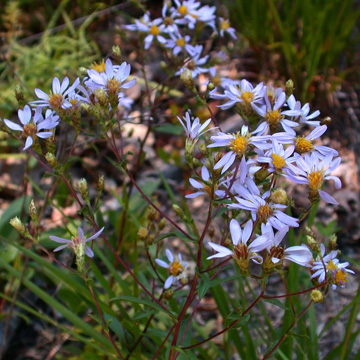

Eurybia compacta - (image 1 of 5)
Taxonomy
Family: Asteraceae
Synonymous with Aster gracilis
Habitat
Dry, sandy soil, often in pine barrens.
Associates
Distribution
Along the coastal plain from NJ to GA.
Morphology
Perennial from a thickened, hard, corm-like base, sometimes also rhizomatous; stems 5-50 cm, several, puberulent or hirtellous to subglabrous; leaves thick, firm, obscurely-veined except for an evident midvein and sometimes a single pair of laterals, more or less entire, not sheathing below; basal leaves with an elliptic blade shorter than the petiole, often deciduous; cauline leaves narrower and mostly sessile, slender; heads several to many in a short and broad, sparsely bracteates corymbiform inflorescence; involucres narrowly obconic or turbinate, 7-12 mm; involucral bracts relatively broad, firm, glabrous or obscurely puberulent, imbricate, the outer with short green tips, the inner scarcely green-tipped or merely with purple margins, commonly some or most shortly squarrose; rays 8-14, blue-violet to rose-purple, often pale, 5-8 mm.
Notes
Flowers: July to October
Wetland indicator: FACU
This species has become extremely rare throughout much of its range. It is reasonably common in southern NJ where these photos were taken.
References
Gleason, Henry A. and A. Cronquist. 1991. Manual of Vascular Plants of
Northeastern United States and Adjacent Canada. Second Ed.
The New York Botanical Garden. Bronx, NY
|
Michael Hough © 2009 |